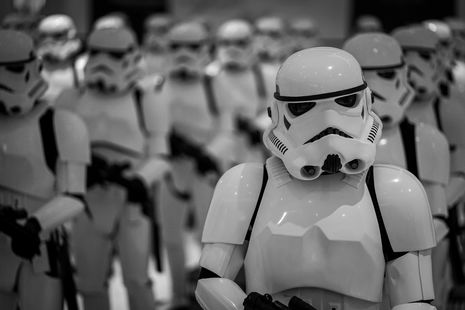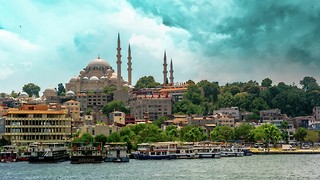‘You see the echo of where it’s all gonna go’: How George Lucas crafted the perfect ending
Mollie McCarthy-Evans analyses why the Star Wars ending is so satisfying

When 20th Century Fox first agreed to fund a new space opera from George Lucas in 1973, the company only envisioned making a single film. Inspired by Flash Gordon and the samurai epics of Akira Kurosawa, Star Wars told the story of a farm boy called Luke Skywalker who joins an uprising against an evil regime and its commander, Darth Vader. Despite the reservations of executives, the film broke box office records upon its release in 1977 and won seven Academy Awards. Naturally, a sequel was soon commissioned, resulting in The Empire Strikes Back in 1980. An altogether more mature film than its predecessor, Empire is now famous for its twist-ending where it is revealed that Darth Vader is Luke’s father. As credits rolled on the franchise’s second instalment, pressure mounted on Lucas to deliver a fitting end to his science-fiction juggernaut.
Although the least commercially successful film in the original trilogy, Return of the Jedi (1983) provides Lucas’ saga with its perfect send-off. The film has much to commend, including excellent effects, action sequences, music, and design. However, what makes Jedi such a fitting conclusion is the extent to which it builds on the previous films. Initially, the story told by the Star Wars saga appears to be relatively simple. During the development of the first film, Lucas became interested in mythology. As a result Star Wars (1977) unfolds according to the ‘hero’s journey’ as a young man hears the call to adventure, rescuing a princess with the help of an old wizard. However, the subsequent Star Wars films work only to reveal the limits of this conventional brand of heroism. This is evident in the opening sequence of Jedi, where Luke initially fails to rescue his friends from Jabba the Hutt.
“What makes Jedi such a fitting conclusion is the extent to which it builds on the previous films”
Building on its opening, the rest of Return of the Jedi is notable for its emphasis on non-violence. This reaches a climax in the film’s third act in which Luke rejects Yoda’s advice and embarks on a mission to redeem his father. This quest takes Luke to the Death Star where he confronts Vader and his father’s own master, Emperor Palpatine. In this sequence, Luke is goaded into fighting Vader and is able to defeat him by giving in to his aggression. However, the sight of Vader’s severed cybernetic hand gives Luke pause as he recalls how his own hand was cut off in Empire. In that moment, Luke realises what he is becoming and throws away his lightsaber. His mercy is soon rewarded as Vader turns on the Emperor, sacrificing himself to save his son. A saga famous for sword fights and space battles is therefore resolved by a man throwing down his weapon and crying for his father. Although Star Wars (1977) positions Luke as a hero, by the end of the third film he has evolved into a Jedi.
“Lucas’ decision to reuse narrative beats means that Vader faces the same scenario twice”
When Return of the Jedi was first released, this was received as an unexpected and thoughtful end to Lucas’ saga. However, the film’s final sequence has only become more impactful since as the franchise has developed. Almost two decades after completing Jedi, George Lucas would return to the Star Wars universe to produce a series of films (and one excellent animated television show) exploring how Anakin Skywalker became Darth Vader. The ‘prequels’ reveal that Anakin was once a decent man who became intoxicated by power while trying to prevent his wife from dying in childbirth. Together, these films serve to re-contextualise Jedi as the final act in Anakin’s tragic story. This allows Vader’s sacrifice to take on a new significance as the Dark Lord is finally able to overcome his selfishness and find freedom from his servitude to Palpatine, exposing the double-meaning of the film’s title as Anakin becomes the Jedi who returns.
The extent to which the end of Luke’s journey is intertwined with that of his father’s is emphasised by Lucas’ directorial choices. This can most clearly be seen in the final film of the prequel trilogy, 2005’s Revenge of the Sith. From its opening sequence, Revenge of the Sith is designed to recall Return of the Jedi. To that end, the two films have a similar structure, beginning with a rescue and building towards a confrontation with Palpatine. However, in Revenge, familiar scenarios are given a darker twist. A particularly important example of this occurs in the film’s climax where Anakin interrupts a fight between Palpatine and a Jedi and chooses to aid the politician. This offers a dark mirror to the confrontation between Luke and the Emperor in Jedi. As well as highlighting the difference between the saga’s two main protagonists, Lucas’ decision to reuse narrative beats means that Vader faces the same scenario twice. As a result, the events of Jedi represent a second chance. As a viewer, it is incredibly satisfying to watch Anakin make the right choice.
 News / Newnham postgrads referred to homeless charities as College runs out of rooms31 July 2025
News / Newnham postgrads referred to homeless charities as College runs out of rooms31 July 2025 Features / Selling the Cambridge experience: private summer programmes in the historic university 3 August 2025
Features / Selling the Cambridge experience: private summer programmes in the historic university 3 August 2025 News / News in Brief: Bare bikers, business and budding scientists3 August 2025
News / News in Brief: Bare bikers, business and budding scientists3 August 2025 News / Two arrested after death of Cambridge language school student 4 August 2025
News / Two arrested after death of Cambridge language school student 4 August 2025 Interviews / A place to Thrive: Cambridge’s all-vegan café and community hub3 August 2025
Interviews / A place to Thrive: Cambridge’s all-vegan café and community hub3 August 2025








